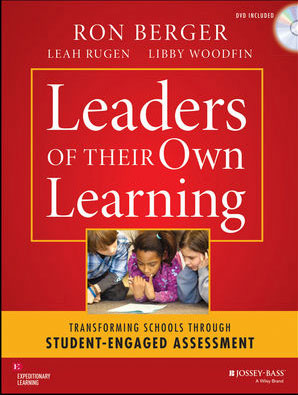The following excerpt is from "Leaders of Their Own Learning: Transforming Schools Through Student-Engaged Assessment," by Ron Berger, Leah Rugen, and Libby Woodfin. This excerpt is from the chapter entitled "Using Data With Students."
At Genesee Community Charter School in Rochester, New York, third-grade teacher Jean Hurst leans in and listens intently as her student, Jacelyn, reads aloud. Hurst is listening for greater fluency in Jacelyn's oral reading, a skill they have been working on for several weeks. As she listens, she hears greater cadence and confidence in Jacelyn's voice. Hurst is careful to note miscues and the length of time it takes Jacelyn to read the passage. They start their follow-up discussion by reviewing Jacelyn's previous goals and successes and reviewing a chart that shows the growth in her reading level. They focus in on fluency and the word substitutions Hurst heard as Jacelyn read aloud. "Let's take a look at this word," says Hurst. "Read it back to me." Jacelyn struggles at first, but calls out the word proclaims. Hurst shares that when she read it aloud, she read it as announces. "We call that a substitution. Do you think you know what happened as you were reading?" Hurst asks. Jacelyn thinks a little more and shares, "Well, I wasn't sure what the word was but I knew it had to mean something like says or announces because of where it was in the sentence."
Hurst and Jacelyn discuss how her substitution enabled her to make sense of what she was reading without slowing down her overall rate. Hurst shares with Jacelyn her Developmental Reading Assessment (DRA) fluency score, and they compare it to older data. It is apparent that her fluency score is improving. Jacelyn is reflective about her growth as a struggling reader: "It's kind of how there are all kinds of runners. Some are fast and some are slow, but we all need to cross the finish line. Well, I just need to move faster than everyone else to get where I need to be." The use of data has helped her (with the guidance of her teacher) to set goals that have moved her from a late kindergarten level in September to an early third-grade level by the end of the year. As Hurst points out, "Although she's still not at grade level, she's made two years of progress and making that progress visible through the use of data has helped Jacelyn to become a more motivated and informed reader."
Using data with students encompasses classroom practices that build students’ capacity to access, analyze, and use data effectively to reflect, set goals, and document growth. Using data with students encompasses the following activities:
- Students use their classwork as a source for data, analyzing strengths, weaknesses, and patterns to improve their work.
- Students regularly analyze evidence of their own progress. They track their progress on assessments and assignments, analyze their errors for patterns, and describe what they see in the data about their current level of performance.
- Students use data to set goals and reflect on their progress over time and incorporate data analysis into student-led conferences.
Teachers and school leaders everywhere collect and analyze data to make informed decisions about instruction that will support all students in meeting state and Common Core standards. However, in many schools, the power of data to improve student achievement is not fully leveraged because students are left out of the process. The most powerful determinants of student growth are the mindsets and learning strategies that students themselves bring to their work—how much they care about working hard and learning, how convinced they are that hard work leads to growth, and how capably they have built strategies to focus, organize, remember, and navigate challenges.

When students themselves identify, analyze, and use data from their learning, they become active agents in their own growth. They set personal goals informed by data they understand, and they own those goals. The framework of student-engaged assessment provides a range of opportunities to involve students in using data to improve their learning. As the story about Jacelyn illustrates, using data with students has the potential to build reflective and confident learners with key dispositions of college and career readiness.


